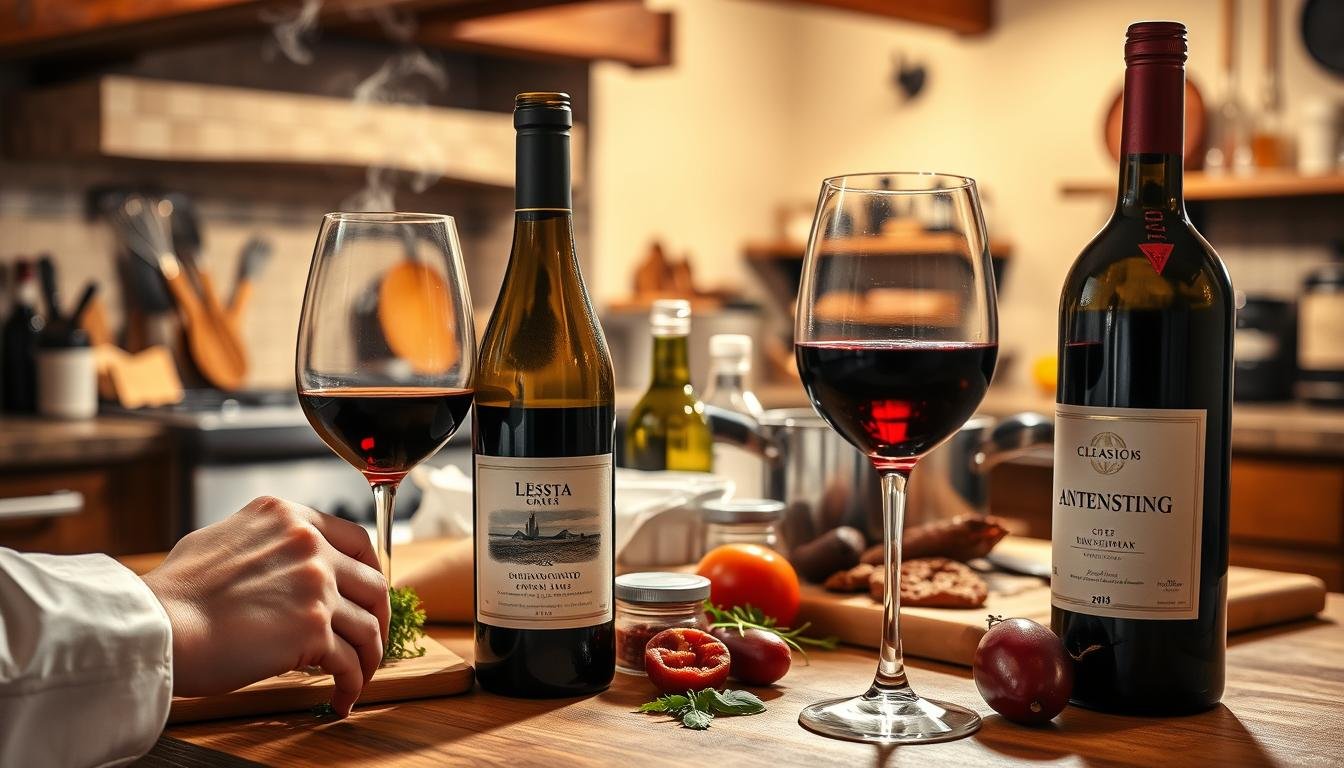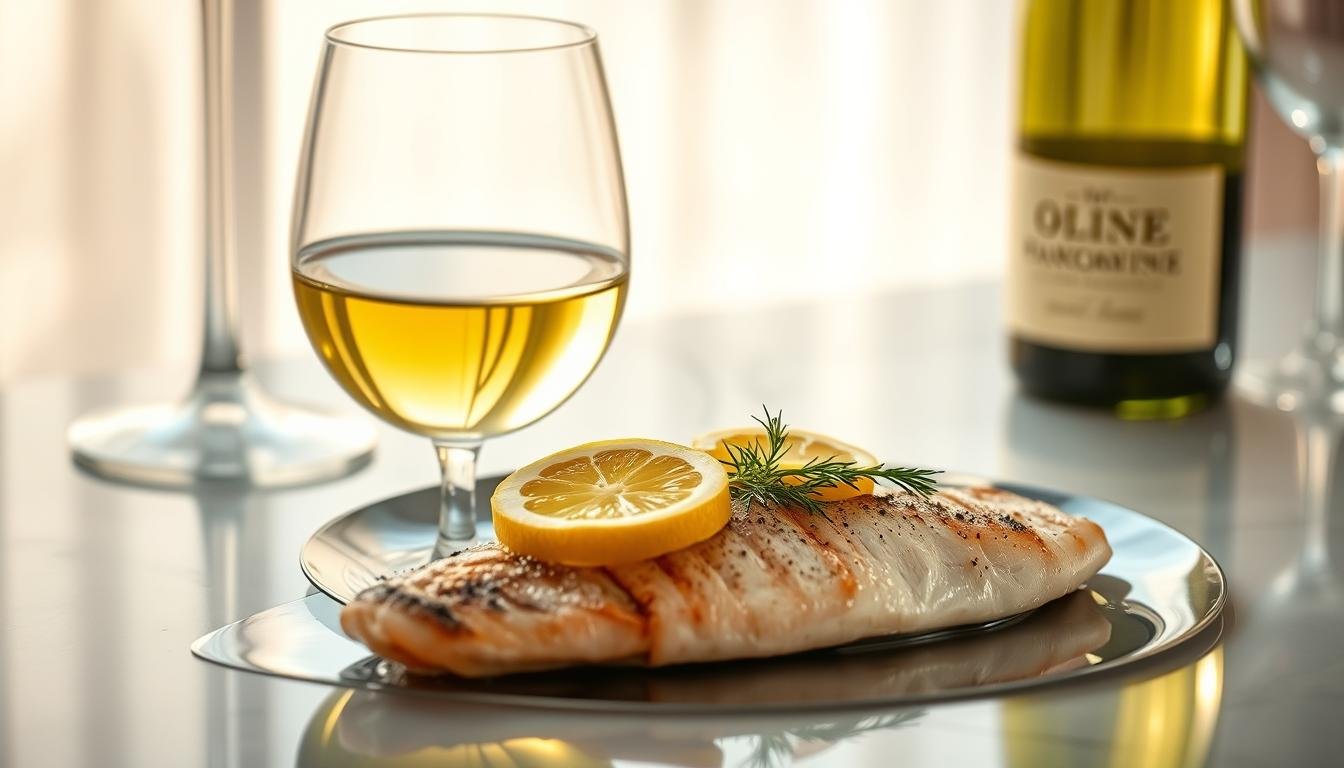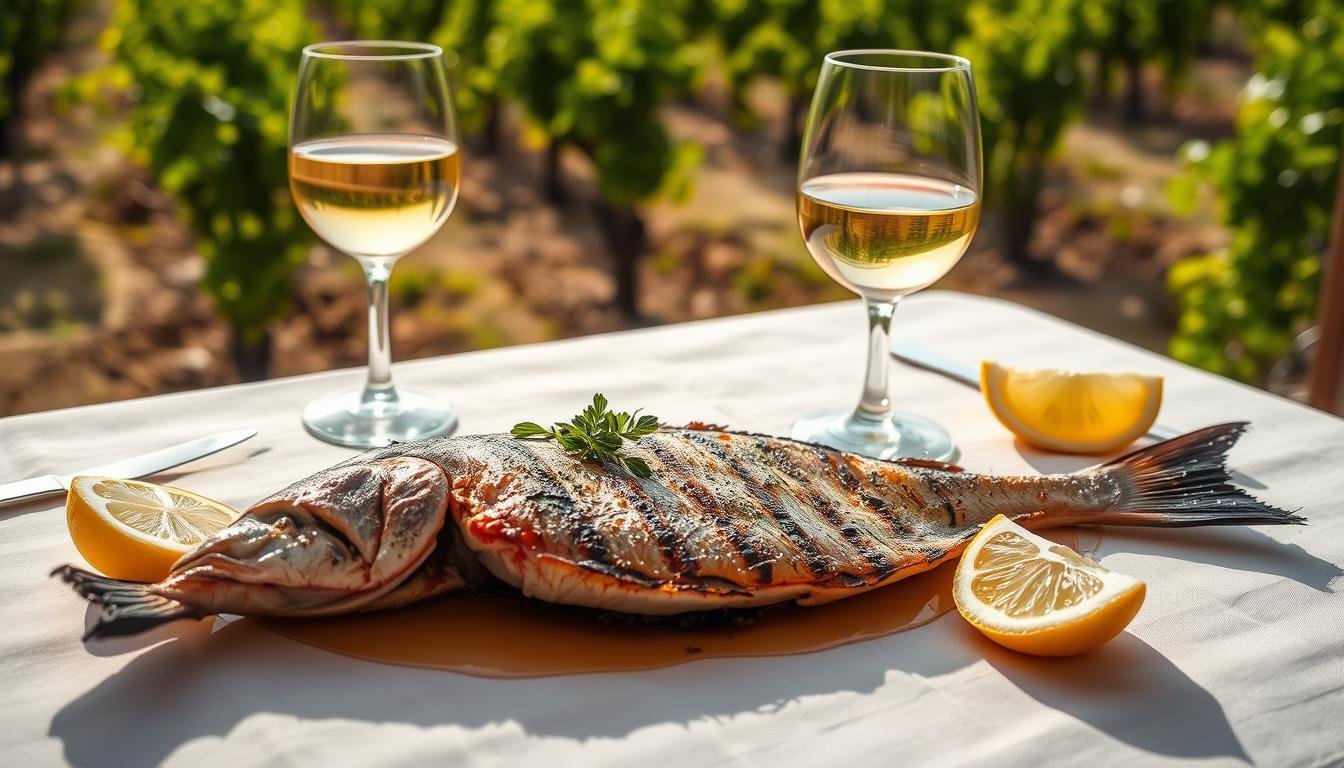When we add wine to a recipe, it shares with our food the unique colors, aromas, and flavors we enjoy when we’re drinking it from a glass. Layering those delicious elements on top of the recipe’s own character builds greater complexity and depth.
The acidity of wine also provides a helpful boost to the other flavors in the dish. By incorporating wine into cooking, we can transform everyday meals into gourmet experiences, adding depth and complexity that can’t be achieved with other ingredients.
Cooking with wine is an effective way to elevate humble weeknight dishes by introducing new flavor dimensions and balancing existing tastes.
Key Takeaways
- Cooking with wine adds depth and complexity to dishes.
- The right wine can elevate weeknight meals into sophisticated experiences.
- Wine works as both a flavor enhancer and a technical ingredient.
- Different wines contribute unique characteristics to dishes.
- Selecting the right wine is crucial for recipe development.
Why Wine Transforms Your Cooking
Wine is a culinary game-changer, elevating dishes with its complex flavors and acidity. When used in cooking, wine can add a richness and depth to various recipes, making it a staple in many professional and home kitchens.
The Science Behind Wine’s Flavor Enhancement
The acidity in wine provides a helpful boost to other flavors in a dish, much like a squeeze of lemon over fish. This fresh lift helps intensify the overall taste experience. Wine contains acids, alcohol, and flavor compounds that work together to enhance food through multiple chemical reactions during cooking.
Benefits of Using Wine in Recipes
Using wine in recipes offers several benefits, including tenderizing meat, releasing fat-soluble flavor compounds, and adding complexity to sauces and stews. The table below summarizes these benefits:
| Benefit | Description |
|---|---|
| Tenderizing Meat | The acids in wine help break down protein fibers, acting as a natural tenderizer. |
| Releasing Flavor Compounds | Wine’s alcohol content helps release fat-soluble flavors in ingredients, creating more aromatic results. |
| Adding Complexity | When wine reduces during cooking, it concentrates flavors and develops new compounds through Maillard reactions. |
As noted by culinary experts, “A good cook will always use wine to add depth to their dishes.” This emphasizes the importance of wine in enhancing the culinary experience.
“A good cook will always use wine to add depth to their dishes.”
In summary, incorporating wine into your cooking can significantly enhance the flavor and complexity of your dishes, making it a valuable ingredient in many recipes.
Choosing the Right Wine for Cooking
When it comes to cooking with wine, the choices can be overwhelming, but the key is simple. The goal is to select a wine that complements your dish without overpowering it.
The “Drink It First” Rule
A fundamental principle in choosing a cooking wine is the “drink it first” rule. This means selecting a wine that you’d enjoy drinking on its own. The idea is that if you wouldn’t drink it, it won’t enhance your food properly. This rule helps in avoiding cooking wines that are often laden with added salt and preservatives.
Understanding Wine Characteristics for Cooking
The character of the wine is crucial. Dry wines with moderate tannins and bright acidity tend to work best in most savory dishes. A wine that’s too sweet can make a dish taste cloying, while one with excessive tannins can become bitter when reduced.
Avoiding Common Wine Selection Mistakes
Common mistakes include using wines that are too sweet for savory dishes or choosing heavily oaked wines that can become bitter when reduced. Understanding these characteristics helps in making a more informed decision when selecting a cooking wine.
Best Red Wines for Cooking
Red wine is a versatile ingredient that can add depth and complexity to a variety of culinary creations. The key to using red wine effectively in cooking is to choose a variety that complements the dish without overpowering it.
The Versatile Merlot
Merlot stands out as a versatile red wine for cooking, offering soft tannins, medium body, and generous fruit flavors. It’s ideal for hearty stews, braised meat dishes, and rich sauces.
Pinot Noir for Delicate Dishes
Pinot Noir is our choice for lighter recipes, such as seared pork loin or red wine sauces with fish or vegetables, where its delicate flavors and silky texture enhance the dish without dominating it.
Cabernet Sauvignon for Rich Meat Dishes
Cabernet Sauvignon, with its structured tannins and intense flavor profile, works best in rich meat dishes like beef stew or braised short ribs.
Zinfandel for Tomato-Based Recipes
Zinfandel brings jammy fruit flavors and spicy notes that pair exceptionally well with tomato-based recipes, making it perfect for pasta sauces or pizza bases.
| Red Wine | Ideal Dish | Characteristics |
|---|---|---|
| Merlot | Hearty stews, braised meat dishes | Soft tannins, medium body, fruit flavors |
| Pinot Noir | Lighter dishes, fish, vegetables | Delicate flavors, silky texture |
| Cabernet Sauvignon | Rich meat dishes, beef stew | Structured tannins, intense flavor |
| Zinfandel | Tomato-based recipes, pasta sauces | Jammy fruit flavors, spicy notes |
For more information on the best red wines, you can visit WineKalli to explore a curated selection of red wines perfect for enhancing your culinary creations.
Best White Wines for Cooking
When it comes to cooking with white wine, the right variety can elevate your dishes to new heights. White wines with good acidity, a light to medium body, and minimal oak influence are ideal for cooking. They enhance the flavors of your recipes without overpowering them.
For more information on white wine varieties, you can visit our comprehensive guide to explore the different types and their characteristics.
Sauvignon Blanc: The Crisp Choice
Sauvignon Blanc is the go-to white wine for cooking when you need bright acidity and herbaceous notes. It’s perfect for seafood dishes, light sauces, and vegetable preparations. Its crisp profile enhances the flavors without overwhelming them.
Pinot Grigio: For Light and Fresh Flavors
Pinot Grigio, also known as Pinot Gris, offers a neutral and crisp profile that is ideal for light pasta dishes, delicate fish recipes, and simple chicken preparations. It adds freshness to your cooking without dominating the other flavors.
Unoaked Chardonnay: For Creamy Sauces
Unoaked Chardonnay provides more body and richness than other white wines without the bitter tannins of oaked varieties. It’s excellent for creamy sauces, risottos, and richer poultry dishes, adding depth and complexity to your recipes.
Sparkling Wine: Unexpected Cooking Star
Sparkling wine is often overlooked for cooking but adds unique brightness to dishes. It works wonderfully in beurre blanc sauces, vinaigrettes, and even desserts like sorbets or poached fruits. Its acidity cuts through richness, balancing the flavors in your cooking.
When cooking with white wine, it’s essential to add it at the right time. For dishes that need to reduce significantly, add the wine earlier in the process. For those where you want to preserve the wine’s bright, fresh characteristics, add it later.
- Sauvignon Blanc is ideal for seafood and light sauces.
- Pinot Grigio is perfect for delicate fish and chicken dishes.
- Unoaked Chardonnay is great for creamy sauces and richer poultry.
- Sparkling wine adds brightness to sauces and desserts.
Popular Wines for Cooking Different Dishes
The right wine can elevate various dishes, from chicken and beef to seafood and pasta. When cooking, the type of wine used can significantly impact the flavor of the final product.
Cooking with wine involves more than just adding any wine to a dish; it’s about selecting a wine that complements the ingredients and enhances the overall flavor. For instance, chicken dishes can benefit from both white and light red wines, depending on the preparation method. Lighter preparations, such as grilled or sautéed chicken, pair well with dry whites like Sauvignon Blanc. In contrast, richer dishes like coq au vin are complemented by lighter-bodied red wines such as Pinot Noir.
Wine Pairings for Chicken Dishes
For chicken, a lighter-bodied red wine like Pinot Noir is often a good choice, as it enhances the flavor without overpowering it. The soft berry notes and gentle acidity of Pinot Noir complement roasted or braised chicken beautifully.
Wine Pairings for Beef and Lamb
Beef and lamb dishes require more robust red wines that can stand up to their rich flavors. Cabernet Sauvignon is an excellent choice for beef stews and roasts, while Syrah/Shiraz pairs well with lamb’s slightly gamey character.
Wine Pairings for Seafood
When it comes to seafood, crisp white wines are typically the best pairing. Sauvignon Blanc adds brightness to dishes like shrimp scampi, while unoaked Chardonnay creates depth in creamy fish dishes. For simple preparations, Pinot Grigio is a wonderful choice.
Wine Pairings for Pasta and Vegetables
Pasta and vegetable dishes require wines that match their sauce or preparation method. Tomato-based pasta dishes benefit from wines like Chianti or Zinfandel. Cream-based sauces work well with unoaked Chardonnay, and vegetable dishes shine with the herbal notes of Sauvignon Blanc. For more information on pairing wine with specific dishes like salmon, you can visit Wine Kalli’s guide on the best wines to pair with.
The key to cooking with wine is matching the intensity of the dish with the intensity of the wine. Delicate dishes require subtle wines, while bold, flavorful dishes can handle more powerful wine additions.
Essential Cooking Techniques Using Wine
Mastering essential cooking techniques using wine can elevate your dishes to new heights. Wine is not just an ingredient; it’s a tool that can transform the flavor and texture of your cooking.
There are several key techniques to understand when cooking with wine. These include deglazing, marinating, creating reductions and sauces, and braising or slow cooking.
Deglazing: Capturing Pan Flavors
Deglazing with wine is a fundamental technique that captures the flavorful browned bits from the bottom of a pan after searing meat or vegetables. This process creates the foundation for many sauces and gravies.
Marinating with Wine
Marinating with wine helps tenderize meat through its acidity while infusing flavor. Red wines work well for beef and lamb, while white wines complement chicken and pork.
Creating Wine Reductions and Sauces
Creating wine reductions involves simmering wine until it reduces by half or more, concentrating flavors and creating a base for sophisticated sauces.
Braising and Slow Cooking with Wine
Braising and slow cooking with wine creates tender, flavorful dishes as the wine’s acidity helps break down tough cuts of meat during the long cooking process.
| Cooking Technique | Description | Best Wine Type |
|---|---|---|
| Deglazing | Captures flavorful browned bits from the pan | Red or White Wine |
| Marinating | Tenderizes meat and infuses flavor | Red for beef/lamb, White for chicken/pork |
| Creating Reductions | Concentrates flavors for sophisticated sauces | Red or White Wine |
| Braising/Slow Cooking | Breaks down tough meat cuts during long cooking | Red Wine |
Wine Substitutes and Storage Tips
You don’t always need wine to enhance your dishes; other ingredients can do the trick. Whether you’re out of wine or just looking for alternatives, there are several options to consider when cooking.
Alternatives When You Don’t Have Wine
If you don’t have a dry white on hand, you can always find a worthy substitute. One excellent replacement is dry vermouth, which not only has a longer shelf life but also replicates much of the same flavors and textures you’ll find with a Pinot Grigio. As noted in our guide on food and wine pairing, understanding the characteristics of wine is crucial for cooking.
- Dry vermouth makes an excellent substitute for dry white wine due to its similar flavor profile and longer shelf life.
- Combining stock (chicken, vegetable, or beef) with a splash of acid like lemon juice or vinegar can mimic wine’s flavor-enhancing properties.
- For red wine substitutes, try mixing grape, pomegranate, or cranberry juice with a splash of vinegar to achieve similar depth and acidity.
Storing Leftover Wine for Cooking
Properly storing leftover wine can extend its usefulness in cooking far beyond its drinking window. To keep it fresh, transfer the leftover wine to smaller bottles to reduce oxygen exposure, and refrigerate it. You can use it within 1-2 weeks for the best results. For longer storage, consider freezing leftover wine in ice cube trays or small containers, creating convenient pre-measured portions for future dishes.
Conclusion: Elevating Your Home Cooking with Wine
With the right bottle of wine, home cooks can unlock new culinary possibilities. Cooking with wine enhances flavors and elevates dishes.
Incorporating wine into recipes can make a significant difference, even with a modest bottle. This ingredient is accessible to cooks of any skill level or budget, allowing for restaurant-quality meals at home.









